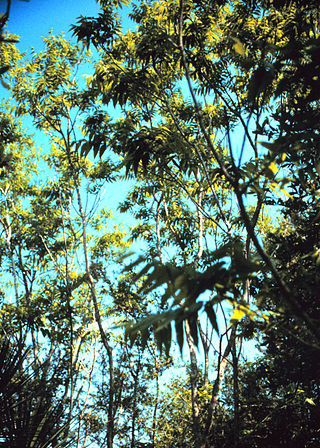Top Qs
Timeline
Chat
Perspective
Sapindus
Genus of flowering plants in the lychee family Sapindaceae From Wikipedia, the free encyclopedia
Remove ads
Sapindus is a genus of about thirteen species of shrubs and small trees in the lychee family, Sapindaceae and tribe Sapindeae. It is native to warm temperate to tropical regions of the world. The genus includes both deciduous and evergreen species. Members of the genus are commonly known as soapberries[3] or soapnuts because the pulp of the fruit is used to make soap and shampoo. The generic name is derived from the Latin words sapo, meaning "soap", and indicus, meaning "of India".[4]
The leaves are alternate, 15–40 cm (5.9–15.7 in) long, pinnate (except in S. oahuensis, which has simple leaves), with 14–30 leaflets, the terminal leaflet often absent. The flowers form in large panicles, each flower small, creamy white. The fruit is a small leathery-skinned drupe 1–2 cm (0.4–0.8 in) in diameter, yellow ripening blackish, containing one seed. Fossils date back to the Cretaceous.[5][6]
Remove ads
Uses


The drupes (soapnuts) contain saponins, which have surfactant properties, being used for washing by ancient Asian and American peoples.[7][8] A number of other uses for Sapindus have also been reported such as making arrows from the wood and decorative objects from the seeds.[9]
Folk medicine
Leaf and fruit extracts of Sapindus have historically been used in folk remedies to treat various conditions.[10]
Insecticide
Sapindus species are used as food plants by the larvae of some Lepidoptera (moths and butterflies) species including Endoclita malabaricus. Kernel extracts of soapnut disrupt the activity of enzymes of larvae and pupae and inhibit the growth of the mosquito Aedes aegypti, an important vector of viral diseases.[11]
Dyeing process
Soapnut is used as a scouring agent for preparation of coloring fibers such as the yarn of Tussar silk and cotton.[12]
Remove ads
Species
Summarize
Perspective


The number of species is disputed between different authors, particularly in North America where between one and three species are accepted. As of February 2024[update], Plants of the World Online includes:[13]
- Sapindus chrysotrichus Gagnep. (southern Vietnam)
- Sapindus delavayi (Franch.) Radlk. (China, India)
- Sapindus drummondii Hook. & Arn. (US: Arizona to SE. Colorado and Louisiana)
- Sapindus emarginatus Vahl (Southern Asia)
- Sapindus lippoldii I.M.Turner (Cuba)
- Sapindus mukorossi Gaertn. – Indian Soapberry (India and the Himalayas east to Indochina and Japan)
- Sapindus oahuensis Hillebr. ex Radlk. – Lonomea (Kauaʻi and Oʻahu, Hawaii)
- Sapindus rarak DC. (Southeast Asia)
- Sapindus saponaria L. – 4 subspecies, previously considered as 2:
- "S. s. var. drummondii" (Hook. & Arn.) L.D.Benson – Western Soapberry (southwestern US, Mexico) is S. drummondii
- S. s. var. saponaria – Wingleaf Soapberry (southeastern US, Caribbean, island of Hawaiʻi, Central, South America);
Sapindus marginatus Willd. – Florida Soapberry – included here.
- Sapindus sonlaensis H.M.Tam, N.K.Khoi, N.T.Cuong & T.B.Tran (Sơn La, NW Vietnam)
- Sapindus tomentosus Kurz – China
- Sapindus trifoliatus L. – South India Soapnut or Three-leaf Soapberry: Southern India, Pakistan (synonym S. laurifolius Vahl = "Ritha")
- Sapindus vitiensis A.Gray (American Samoa, Samoa, Fiji)[3][14][15]
Formerly placed here
- Lepisanthes fruticosa (Roxb.) Leenh. (as S. fruticosus Roxb.)
- Lepisanthes senegalensis (Juss. ex Poir.) Leenh. (as S. senegalensis Juss. ex Poir.)
- Lepisanthes tetraphylla (Vahl) Radlk. (as S. tetraphylla Vahl)
- Talisia cerasina (Benth.) Radlk. (as S. cerasinus Benth.)
- Talisia esculenta (A.St.-Hil.) Radlk. (as S. esculenta A.St.-Hil.)[15]
Remove ads
References
External links
Wikiwand - on
Seamless Wikipedia browsing. On steroids.
Remove ads

